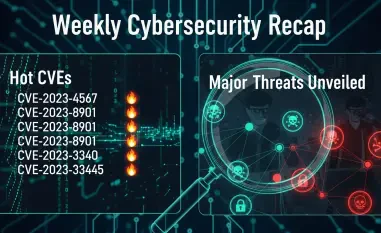The cybersecurity landscape is evolving at an unprecedented pace, driven by the increasing sophistication of cyber threats and the rapid adoption of new technologies. As we approach 2025, organizations must stay ahead of these trends to protect their data, maintain trust, and avoid costly downtime. This article delves into the top 10 cybersecurity trends for 2025, offering insights and practical solutions to help organizations navigate the evolving threat landscape.
The Evolving Threat Landscape
The evolving threat landscape continuously presents new challenges for cybersecurity professionals and organizations worldwide. As technology advances, so do the tactics and tools used by malicious actors, making it imperative for those in the cybersecurity field to stay vigilant and proactive in their defense strategies. The need for robust, adaptive security measures has never been more crucial as threats become more sophisticated and targeted.
Surge in Vulnerabilities
The number of disclosed vulnerabilities has surged, with over 30,000 reported last year alone, marking a 17% increase. This rise is attributed to the growing complexity of IT environments and the proliferation of connected devices. Cybercriminals are exploiting these vulnerabilities to target endpoints and data flows, especially with the increase in remote work and cloud adoption. Organizations must adopt robust vulnerability management programs to stay ahead of these threats.
In today’s interconnected world, the attack surface is expanding rapidly, with new vulnerabilities being discovered daily. The sheer volume of data and services interconnected through the Internet of Things (IoT) and cloud platforms creates an expansive landscape for cybercriminals to exploit. As the number of potential entry points increases, fortified defenses and vigilant monitoring become essential. This escalation necessitates a multifaceted approach to security, involving rigorous vulnerability assessments, automated patch management, and an agile response strategy to address newly discovered vulnerabilities swiftly.
Advanced Technologies in Cyber Attacks
Adversaries are leveraging advanced technologies such as AI and machine learning to enhance their attack capabilities. These technologies enable cybercriminals to automate and scale their attacks, making them more effective and harder to detect. Organizations need to invest in advanced threat detection and response solutions to combat these sophisticated attacks.
The sophistication of cybercriminals has reached new heights, as they now harness AI and machine learning to outsmart traditional security measures. These advanced technologies allow attacks to be executed with precision, often bypassing conventional detection systems. For instance, AI can be used to create phishing emails that are highly personalized and convincing, increasing the likelihood of success. Meanwhile, machine learning algorithms can analyze defenses and adapt attacks in real-time. To counter these intelligent threats, organizations must deploy equally sophisticated defense mechanisms. This includes AI-powered anomaly detection systems that learn and recognize normal behaviors to identify deviations indicative of malicious activity.
AI-Driven Malware
Real-Time Mutation of Malicious Code
One of the most pressing concerns is the emergence of AI-driven malware. Cybercriminals are using machine learning to mutate malicious code in real-time, making it harder to detect. This technology allows malware to adapt to endpoint defenses, rendering traditional manual threat-hunting methods obsolete. Organizations must adopt advanced anomaly detection techniques to combat these sophisticated threats.
The dynamic nature of AI-driven malware presents a formidable challenge for traditional cybersecurity measures. Unlike static malware, which remains unchanged once deployed, AI-driven variants can continuously evolve, modifying code patterns to avoid detection. This constant mutation complicates efforts to identify and neutralize threats using conventional signature-based detection methods. By the time a cybersecurity team identifies a particular strain of malware, it may have already morphed into a new variant. To stay ahead of these adaptive threats, businesses need to implement machine learning-based anomaly detection systems. These systems leverage advanced algorithms to pinpoint unusual behaviors indicative of potential threats.
Advanced Anomaly Detection Techniques
To counter AI-driven malware, organizations need to implement advanced anomaly detection techniques. These techniques leverage machine learning and behavioral analysis to identify deviations from normal activity, enabling the detection of previously unknown threats. By continuously monitoring for anomalies, organizations can stay ahead of evolving malware threats.
Traditional cybersecurity measures often rely on predefined rules and signatures to detect threats, which can be easily circumvented by evolving malware. Advanced anomaly detection offers a more proactive approach by focusing on behavioral patterns rather than static indicators. This method employs machine learning algorithms to establish baselines of normal activity across various systems and networks. Any deviation from these baselines triggers an alert, signaling potential malfeasance. With continuous monitoring, organizations can detect even the most subtle changes indicative of sophisticated malware. This holistic approach, combining behavioral analysis with machine learning, provides a robust defense mechanism capable of adapting to the ever-changing threat landscape.
Zero Trust Architectures
Continuous Validation of Every Request
With the obsolescence of perimeter-based security, zero trust architectures have become a critical trend. Zero trust models require continuous validation of every request, providing a robust defense against lateral movement—a common characteristic of advanced breaches. This approach includes micro-segmentation, user context checks, and continuous session monitoring.
In a zero trust environment, the assumption that any entity, whether user or device, is inherently trustworthy does not exist. Every access request is scrutinized, validated, and verified continuously, regardless of the origin or prior authentication status. This constant vigilance thwarts attempts at lateral movement within a network—a tactic often used by attackers to escalate privileges and propagate to other systems once an initial foothold is gained. Implementing zero trust involves segmenting the network into smaller, controlled units, each governed by stringent access controls and real-time monitoring. This ensures that even if an intruder manages to breach one segment, they are contained without access to broader network assets.
Micro-Segmentation and User Context Checks
Micro-segmentation involves dividing the network into smaller segments, each with its own security controls. This limits the potential impact of a breach by containing it within a segment. User context checks involve verifying the identity and context of users before granting access to resources. These measures are essential for implementing a zero trust architecture.
Micro-segmentation is akin to compartmentalization within a network, where different areas are isolated and protected independently. Each segment operates with its own set of security policies and controls, minimizing the risk of widespread damage in case of a breach. For example, critical systems such as payment processing servers and databases can be isolated from general business operations. Alongside micro-segmentation, user context checks play an equally pivotal role. These checks validate not just the user’s identity but also their current context—such as location, device health, and behavioral patterns—before permitting access. Together, these measures fortify a zero trust framework by ensuring that each segment of the network is securely managed and access is scrupulously controlled.
Quantum Computing Threats
Potential to Break Contemporary Encryption
Although not yet mainstream, quantum computing poses a significant future threat as it can potentially break contemporary encryption methods. Cybercriminals may intercept and store encrypted data with the hope of decrypting it using quantum hardware in the future. Organizations must adopt quantum-resistant algorithms to safeguard critical data against these long-term decryption risks.
Quantum computing represents a paradigm shift in computational power, capable of processing complex calculations at unprecedented speeds. While this holds promising potential for scientific and technological advancements, it also poses a looming threat to current encryption standards. Quantum algorithms, particularly Shor’s algorithm, can theoretically solve problems that are currently infeasible for classical computers—for example, factoring large numbers that secure cryptographic keys. Consequently, data encrypted with contemporary algorithms might be at risk of future decryption when quantum computing becomes practically viable. Cybersecurity strategies must evolve accordingly, adopting quantum-resistant cryptographic algorithms designed to withstand such computational prowess and ensure long-term data protection.
Adoption of Quantum-Resistant Algorithms
In response to the potential threats posed by quantum computing, the adoption of quantum-resistant algorithms has become increasingly important. These algorithms are designed to secure data against quantum attacks, ensuring that sensitive information remains protected in a post-quantum world. Researchers and industry experts are collaborating to develop and implement these advanced cryptographic solutions, aiming to maintain the integrity and confidentiality of digital communications as technology evolves.
To prepare for the potential threats posed by quantum computing, organizations need to adopt quantum-resistant algorithms. These algorithms are designed to withstand the computational power of quantum computers, ensuring the long-term security of encrypted data. By transitioning to quantum-resistant encryption, organizations can future-proof their data protection strategies.
Quantum-resistant algorithms, also known as post-quantum cryptography, are being developed to counteract the threats posed by quantum computing. These algorithms aim to provide a level of security that remains robust even against quantum attacks. Research in this field is vigorous, with various cryptographic methods under scrutiny for their potential to replace or augment existing standards. Transitioning to quantum-resistant encryption involves evaluating current cryptographic assets and preparing infrastructure capable of supporting these advanced algorithms. Organizations must stay informed about the advancements in this domain and proactively integrate quantum-resistant solutions into their cybersecurity frameworks to ensure resilience against future quantum threats.
Ransomware-as-a-Service (RaaS)
Ransomware-as-a-Service (RaaS) has emerged as a significant threat in the cybersecurity landscape, enabling cybercriminals to rent out ransomware tools and infrastructure to carry out attacks. This model allows individuals with limited technical expertise to execute sophisticated ransomware attacks, making it easier for cybercriminals to target businesses and individuals. RaaS operators typically offer user-friendly interfaces, customer support, and even profit-sharing schemes, lowering the barriers to entry for aspiring hackers. The proliferation of RaaS has led to an increase in ransomware incidents, posing a growing challenge for cybersecurity professionals and organizations worldwide.
Surge in Ransomware Attacks
Ransomware groups are increasingly offering Ransomware-as-a-Service (RaaS), providing affiliates with easy-to-use toolkits in exchange for a share of the profits. This lowers the barrier to entry, leading to a surge in ransomware attacks. The average cost of recovering from a ransomware attack has risen to USD 2.73 million. To mitigate these risks, organizations should maintain offline backups and implement segmented networks.
The proliferation of Ransomware-as-a-Service (RaaS) has democratized cybercrime, allowing even those with limited technical skills to deploy devastating ransomware attacks. This has resulted in a marked increase in the frequency and severity of such incidents. The RaaS model operates similarly to legitimate Software-as-a-Service (SaaS) platforms, where subscribers gain access to sophisticated ransomware toolkits and infrastructure in return for a portion of the extorted payments. The impact on organizations can be severe, ranging from significant financial losses to operational disruptions and reputational damage. To defend against this pervasive threat, it is imperative to maintain comprehensive security infrastructures, including segmented networks to contain outbreaks.
Offline Backups and Segmented Networks
Maintaining offline backups is crucial for recovering from ransomware attacks without paying the ransom. Segmented networks limit the spread of ransomware by isolating different parts of the network. These measures, combined with regular security training and awareness programs, can help organizations defend against the growing threat of ransomware.
Backup strategies have evolved as a critical component of cybersecurity defenses, especially amidst the rising threat of ransomware. Offline backups, disconnected from the primary network, act as a fail-safe, ensuring that critical data can be restored without succumbing to extortion demands. However, merely having backups is not enough. Regular testing and verification of backup integrity and restoration processes are essential to ensure reliability during a crisis. Network segmentation complements this by isolating various network sections, effectively quarantining any infected segment to prevent malware spread. Combining these technical measures with continuous staff training on phishing and other social engineering tactics creates a robust, multi-layered defense strategy.
5G and Edge Security Risks
New Vulnerabilities with 5G and Edge Computing
The adoption of 5G and edge computing introduces new vulnerabilities, as data volumes increase and real-time use cases extend to IoT and industrial control systems. These risks necessitate comprehensive risk management strategies, including firmware updates and identity checks at the edge.
The introduction of 5G technology promises to revolutionize communications with unprecedented speed and connectivity, but with this transformation comes new security challenges. The high bandwidth and low latency offered by 5G will enable a proliferation of IoT devices and edge computing applications, from smart cities to autonomous vehicles. However, each new connected device potentially opens a new attack vector. Cyber adversaries may exploit these vulnerabilities to gain control over critical systems or intercept sensitive data. Thus, robust risk management strategies must be developed to address these emerging threats. Continuous firmware updates and stringent identity verification protocols at the edge are essential.
Comprehensive Risk Management Strategies
To address the security risks associated with 5G and edge computing, organizations need to implement comprehensive risk management strategies. This includes regular firmware updates to address vulnerabilities, identity checks to verify the authenticity of devices, and continuous monitoring of edge environments. By proactively managing these risks, organizations can secure their 5G and edge deployments.
Deploying a secure 5G and edge computing infrastructure requires a multi-pronged risk management approach. Regular firmware updates are a fundamental practice, ensuring that devices operate on the latest, most secure software versions. This mitigates the risk of known vulnerabilities being exploited by malicious actors. Identity checks are equally critical, verifying the authenticity and integrity of devices and users seeking access to the network. Continuous monitoring offers another layer of security, providing real-time insights into edge activities and potential anomalies. Implementing these measures creates a resilient defense framework capable of safeguarding the expansive and dynamic environment of 5G and edge computing.
Insider Threats Amplified by Hybrid Work
Organizations need to address the growing concern of insider threats amplified by the hybrid work model, which combines remote and in-office work arrangements. The dispersion of the workforce creates new security vulnerabilities as employees access sensitive data and systems from various locations, often using personal devices and unsecured networks. Therefore, it is crucial for companies to adopt comprehensive security strategies, incorporating advanced monitoring tools and robust access controls to mitigate these risks and safeguard their valuable information.
Increased Risk from Remote Staff and Contractors
The surge in remote work and use of contractors has created new opportunities for insider threats, whether intentional or accidental. With employees working from various locations and devices, monitoring and securing data access becomes increasingly challenging. Unintentional actions by remote staff, such as using unsecured networks or falling for phishing scams, can lead to significant breaches. Moreover, malicious activities by disgruntled employees or contractors seeking financial gain or revenge further amplify risks. Organizations must adopt comprehensive strategies to monitor and mitigate the risks from insider threats.
The transition to a hybrid work model, blending remote and on-site work, has exacerbated insider threats significantly. Employees accessing corporate resources from personal devices and unsecured networks often bypass the organization’s security controls, increasing vulnerability. Moreover, the dispersed nature of work environments makes it harder to monitor and secure data consistently. Implementing robust endpoint protection software, carrying out regular risk assessments, and deploying unified endpoint management (UEM) solutions are critical steps in this new dynamic. Additionally, fostering a culture of awareness by educating employees about potential threats and best practices for secure behavior online is imperative.
Behavioral Analysis and Data Loss Prevention Tools
To counter these elevated risks, organizations need to implement behavioral analysis and data loss prevention (DLP) tools. Behavioral analysis helps in identifying abnormal activities or deviations in user behavior that could indicate potential insider threats. Data loss prevention tools are designed to prevent unauthorized access, sharing, or downloading of sensitive data. These tools, combined with regular monitoring and stringent access controls, can help mitigate the risks posed by insider threats in a hybrid work environment.
Behavioral analysis tools leverage advanced algorithms and machine learning to establish baselines of normal user activities. By doing so, these tools can detect anomalous behaviors indicative of insider threats, such as unusual login times, accessing data not typically related to a user’s role, or attempts to transfer sensitive information. Once flagged, these anomalies can be investigated and acted upon swiftly. Data loss prevention tools provide another critical layer of security. These systems can monitor, identify, and restrict the movement of sensitive data, ensuring that only authorized personnel access it. Implementing role-based access controls and least privilege principles further minimizes the risk of internal data breaches.
Supply Chain Attacks
Supply chain attacks are a growing concern in the cybersecurity landscape. These types of attacks exploit the vulnerabilities in the supply chain, targeting the weakest link to compromise the entire system. By infiltrating third-party vendors or service providers, attackers can gain access to a wealth of sensitive information and disrupt operations on a large scale. As businesses increasingly rely on interconnected networks, the importance of securing every part of the supply chain cannot be overstated. Addressing these threats requires a comprehensive approach, including thorough vetting of suppliers, continuous monitoring, and robust security practices across all levels of the supply chain.
High-Profile Incidents and Threats
Supply chain attacks, where attackers compromise vendors or third-party software to infiltrate multiple downstream organizations, remain a significant concern. High-profile incidents, such as the SolarWinds breach, underscore the need for thorough vetting of suppliers’ security postures and continuous compliance monitoring.
The SolarWinds breach served as a stark reminder of the vulnerabilities within supply chains, highlighting how an attack on a single supplier can have cascading effects on numerous organizations. Cybercriminals exploiting these vectors can gain widespread access, often utilizing the compromised supplier’s trust relationship to infiltrate several entities. The complexity and interconnectedness of modern supply chains make such attacks both attractive and challenging to detect. Consequently, rigorous vetting procedures for suppliers and partners are mandatory. This includes assessing their cybersecurity policies, incident response plans, and overall security posture to ensure they meet stringent standards before integration into your ecosystem.
Continuous Compliance Monitoring and Vetting of Suppliers
Continuous compliance monitoring is essential to ensure that vendors and third-party partners adhere to security standards over time. Regular audits, security assessments, and real-time threat intelligence sharing among ecosystem partners can provide ongoing assurance. Implementing robust contracts with security requirements and obligations for vendors, as well as having contingency plans for potential supply chain disruptions, are also key.
Maintaining an up-to-date security assessment and compliance monitoring framework for all suppliers is vital for mitigating supply chain risks. This entails regular penetration testing, security audits, and adherence to industry-specific regulations and standards. Contracts with third-party vendors should include clear security requirements and outline obligations for compliance and timely communication of security incidents. Additionally, fostering partnerships in threat intelligence sharing can enhance awareness and preparedness against emerging threats affecting the entire supply chain. Developing and rehearsing contingency plans ensure that organizations can respond swiftly to supply chain breaches, minimizing operational disruptions and data exposure.
Cloud Container Vulnerabilities
Risks of Misconfigurations and Unpatched Images
While cloud containers and microservices offer agility, they also introduce new attack vectors if misconfigurations or unpatched images persist. Embedding security checks in DevOps pipelines is essential to prevent data exfiltration or malicious code injection. This trend highlights the importance of “shift-left” security practices.
Containers and microservices are integral to modern cloud architectures, promoting scalability and efficiency. However, they also present unique security challenges. Misconfigurations—such as incorrect permissions or unprotected APIs—create significant vulnerabilities, potentially exposing sensitive data or enabling unauthorized access. Unpatched container images can harbor known vulnerabilities, making them attractive targets for attackers. To address these risks, integrating security early in the development lifecycle, commonly referred to as “shift-left” security, is paramount. By embedding security controls within DevOps workflows, organizations can identify and remediate vulnerabilities before deployment.
Embedding Security in DevOps and Shift-Left Practices
Integrating security directly into the DevOps pipeline ensures that security measures are applied consistently throughout the development and deployment phases. Automated security testing, continuous integration and continuous delivery (CI/CD) pipelines, and regular vulnerability scanning can help identify and address security issues early. Adopting a shift-left approach encourages developers to take responsibility for security, embedding it into their processes and establishing a proactive security culture within the organization.
A shift-left approach to security involves embedding security considerations from the earliest stages of the software development lifecycle. This proactive strategy requires incorporating automated security tools within CI/CD pipelines to perform continuous testing, vulnerability scanning, and compliance checks. Tools like static application security testing (SAST) and dynamic application security testing (DAST) can identify code-level vulnerabilities and runtime risks, respectively. Encouraging developers to adopt secure coding practices and providing ongoing training further promotes a culture of security awareness. By embracing shift-left practices, organizations not only enhance the security of their applications but also streamline the overall development process, reducing the time and cost associated with late-stage vulnerability remediation.
Social Engineering via Deepfakes
Sophisticated Audio-Video Manipulations
Deepfake technology, which allows scammers to convincingly impersonate executives or celebrities, poses a significant threat. These sophisticated audio-video manipulations can lead to credential theft and fraudulent transactions. Organizations must invest in awareness training and advanced verification steps to combat deepfake phishing.
Deepfake technology leverages cutting-edge advancements in AI to create highly realistic but fake audio and video content. Fraudsters can use this technology to impersonate senior executives or trusted figures, manipulating both visual and audio cues to deceive their targets. Such impersonations can convince individuals to disclose confidential information, authorize financial transactions, or even alter operational procedures. The risks associated with deepfakes necessitate a multi-faceted defense strategy. Implementing advanced verification methods, such as multi-factor authentication and real-time voice or facial recognition, can mitigate the threat posed by these manipulative technologies.
Awareness Training and Advanced Verification Steps
The cybersecurity landscape is evolving at an unprecedented rate, driven by increasingly sophisticated cyber threats and the swift adoption of new technologies. As we look toward 2025, it is crucial for organizations to anticipate these trends to safeguard their data, maintain trust, and avoid expensive downtime. This article explores the top 10 cybersecurity trends for 2025, providing valuable insights and actionable solutions to help businesses navigate the ever-changing threat landscape.
Among the significant trends are the increased use of artificial intelligence and machine learning for threat detection and response. These technologies will become essential in identifying and mitigating threats in real-time. Additionally, the rise of 5G technology will introduce new security challenges, requiring organizations to rethink their network security strategies. Cloud security will also remain a top priority as more companies migrate their data and services to cloud platforms.
Furthermore, the proliferation of Internet of Things (IoT) devices will expand the attack surface, necessitating improved security measures for connected devices. Zero Trust architecture will continue to gain traction, emphasizing the need for strict identity verification and access controls. Cybersecurity workforce shortages will push organizations to invest more in training and development to build a skilled workforce capable of addressing these challenges.
By staying informed about these emerging trends and implementing the recommended solutions, organizations can better protect their assets and ensure resilience against future cyber threats.













